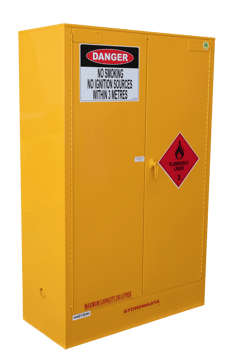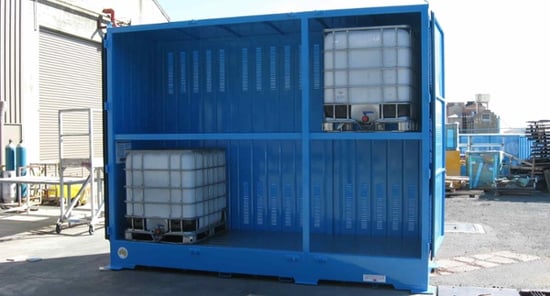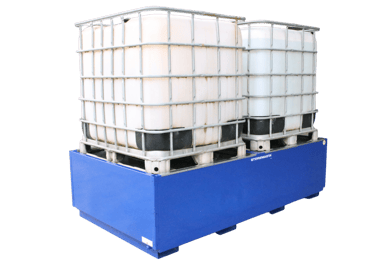Chemical spills in the workplace pose a great range of risks. They can put your workers at risk, cause fires or explosions, devastate the natural environment and affect the local community. To avoid these dangerous incidences, and comply with Australian WHS Regulations, you must implement a spill containment system to reduce your risk. This blog is dedicated to helping businesses achieve compliance by detailing 6 quick ways you can minimise chemical spill risk — particularly if your business carries Class 3 Flammable Liquids.
Where there is a risk from a leak or spill of a hazardous chemical — provision is made in each part of the workplace where the hazardous chemical is used, handled, generated or stored — for a spill containment system that contains any spills or leaks, and any resulting effluent.
Section 357 Containing and managing spills
Model WHS Regulations
1. Use Indoor Flammable Cabinets 
Do you want to immediately reduce your chemical spill risk? The first, and arguably the easiest, risk control measure is to store your flammable and combustible liquids inside a safety cabinet.
You must ensure that your flammable liquids storage cabinet has been manufactured to the specifications of AS1940:2017 – The storage and handling of flammable and combustible liquid.
These durable cabinets are made from double-walled sheet steel and are manufactured to be liquid-tight. They are capable of safely containing chemical leaks, spills and hazardous flammable vapours.
The flammable cabinet doors are self-closing and tight-fitting, which assists in the containment of flammable liquid spills. The lower compound (at least 150 mm deep) is designed to hold 25% of the entire contents of the cabinet.
The spill containment system within the cabinet works perfectly because the shelving is angled to direct all leaks and spills into the spill sump below. Plus, you can make your cabinet even safer by using spill trays and replaceable bung plugs.
IMPORTANT: In addition to choosing a compliant flammable cabinet, you should also ensure that you only store Class 3 Flammable Liquids in the cabinet and it’s never loaded past its maximum capacity (which can be found on the front of the cabinet).
2. Choose An Outdoor Store With Spill Containment
Outdoors, there is still the risk of chemical spills occurring from the misuse or mishandling of flammable liquids. However, there is the added risk of impact damage (such as vehicles or forklifts knocking into the cabinet) in the outside environment. There are also environmental elements to consider, such as severe storms and high winds which can damage or destabilise chemical stores.
And because outdoor locations are generally used for the storage of large quantities of flammable liquids, it’s vital that your chemicals are stored and handled with the utmost care. Storing larger quantities of flammable liquids comes with a greater risk for a devastating chemical spill.

Storing your chemicals outdoors can be done safely by choosing an outdoor flammable liquid store that meets Australian Standards.
To minimise the likelihood and impact of a flammable liquids spill, you can choose to store your chemicals in an outdoor flammable liquid store that’s been constructed to meet the requirements of AS 1940:2017.
Features of compliant stores include:
- Specifically designed for the safe storage of Class 3 Dangerous Goods
- Liquid-tight spill containment sump
- Cyclone-proof construction
- Cambered roof to assist with rainwater runoff
- ISO locking bars
- Ventilators that comply with AS 1940:2004
3. Install A Lube Station Oil Dispensing System
As Dangerous Goods Storage Specialists, we’ve spoken with thousands of businesses about how to reduce the many risks associated with handling and storing flammable liquids.
In particular, the dispensing of oil is a process that can create a range of serious risks, including fire, explosion, human harm and environmental damage.
To create a smooth and seamless dispensing experience for our customers, we’ve created the Storemasta Lube Station. This oil dispensing system safely dispenses chemicals accurately and cleanly — significantly reducing the risk of chemical spills.
Suited for both IBC or drum storage, the dispensing system utilises quick connect fittings and the main chemical storage area is closed and completely secure. As there’s no more lugging and manoeuvring of heavy oil drums around the jobsite, the dispensing process becomes safer and more efficient.
STOREMASTA Lube Stations are completely portable, so they’re ideal for remote sites. They feature forklift channels, lashing points, engineered footings and crane lifting lugs for safe transfer, if required.
4. Place Steel Bunds Under Your Pallets, Drums and IBCs
It doesn’t matter whether your flammable liquids are stored in 205 litres drums, IBCs, paint tins, or jerry cans — the WHS Regulations are clear — you must have sufficient chemical spill protection.
 If you’re carrying flammable liquids, you must choose steel bunding as the material is resistant to both chemical attack and fire.
If you’re carrying flammable liquids, you must choose steel bunding as the material is resistant to both chemical attack and fire.
Here are some compliant solutions that offer immediate spill protection for flammable and combustible liquids:
- Heavy duty steel bunds with grate, and integrated drain valve — holding 2 or 4 x 205 litre drums. Steel grated bunds can also be used to store paint tins, jerry cans, flammable cleaning chemicals, oils and solvents.
- Heavy duty steel bunds (with grate) and powder-coat finishing — holding 1 or 2 IBCs.
- Polyethylene ramps — to easily load and unload drums on (and off) the bunds, reducing spillage.
- Dispensing trays which seamlessly fit the IBC bunds — to reduce spillage during decanting.
REMEMBER: According to Australian Safety Standard AS1940:2017, bunding and spill containment systems for ALL flammable and combustible liquids MUST be constructed from materials that are both chemically resistant AND fire resistant (like steel).
5. Transfer Chemicals Using Drum Dollies and Bunded Trollies
Chemical spills don’t just happen when flammable liquids are being used, dispensed or stored.
Many chemical spills happen when chemical drums and containers are being moved around the job site — whether they’re being delivered, transferred or used for decanting purposes.
If your business utilises a system of drum dollies, bunded trollies — and add-ons such as lids and pourers — you can create an effective (and immediate) spill protection solution.
Just remember, that these options don’t apply to Class 3 Flammable Liquids — as flammables and combustibles must have spill bunding that’s both chemical resistant and fire resistant.
Polyethylene drum dollies, bunded trollies, pourers and lids are ideal for Dangerous Goods such as:
- corrosive substances
- toxic substances
- oxidising agents
- organic peroxides
If your organisation carries the above-mentioned substances, some spill prevention options that you may like to consider include:
- Drum dolly with steel handle makes a single 205 litre drum portable — or create a chemical waste station on wheels.
- Polyethylene bunded trolley for safely transporting 4 x 205 litre drums — features swivel cast wheels and steel handle.
- Polyethylene lid fits perfectly over a 205 litre drum — sealing chemical vapours and minimising liquid spills.
- Spill funnels with debris strainers can be attached to both 205 litre drums and IBCs — minimises over-pour spillage while decanting.
6. Use Bunded Caddies When Decanting 205 Litre Drums
Do you need some spill protection during the decanting process? Drum caddies offer reliable spill protection for oil and fuel drums.
For superior chemical spill protection, look out for 205 litre drum caddies that feature:
- Swivel cast wheels (for easy manoeuvrability).
- Double-walled body (fully leak-proof).
- Ratchet straps (for ensuring the drums stay perfectly in place).
- Heavy duty Polyethylene construction (100% corrosion free).
- Enough space so portable containers are fully contained during dispensing.
How Can You Minimise Chemical Spill Risk In Your Organisation?
We hope you’ve gained some knowledge and know-how with our 6 quick ways to minimise chemical spill risk. If you’re ready to take the next step in flammable liquids safety and compliance, why not access our handy eBook? Essential Considerations When Storing Flammable Liquids Indoors outlines the correct procedures for storing flammable liquids in compliant safety cabinets. It will also take you through the steps required when carrying out a full risk assessment. Grab your copy for free today.

Living life by the 4 C’s of marketing – communication, coffee, compliance… and more coffee – Leisa Andersen is Storemasta’s Content Marketing Manager. When she’s not writing, you’ll find her enjoying all the good things in life, including shopping, travel and gluten free donuts.
